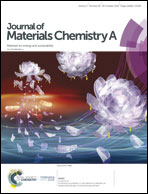An interfacial crosslinking strategy to fabricate an ultrathin two-dimensional composite of silicon oxycarbide-enwrapped silicon nanoparticles for high-performance lithium storage†
Abstract
A simple yet efficient interfacial crosslinking strategy was developed to fabricate an ultrathin two-dimensional composite in which silicon nanoparticles are uniformly enwrapped in silicon oxycarbide nanosheets (Si/SiOC-NS). The conceptual interfacial crosslinking strategy includes polymeric precipitation at the oil/water interface and simultaneous in situ crosslinking of organosilicon polymers, which overcomes the bottleneck of the conventional sol–gel method to synthesize 2D precursors for SiOC. Moreover, the nanostructures of precursors are well-controlled because of the facile precipitation process. The high aspect ratio of the as-obtained Si/SiOC-NSs exposes a large surface to the electrolyte and facilitates the penetration and diffusion of Li ions around Si nanoparticles. The stable SiOC matrix not only buffers the volume changes of active materials during the charge–discharge process but also contributes to lithium storage. As a result, the anodes of LIBs based on Si/SiOC-NS deliver excellent rate capability (a high capacity retention rate of 65% at 1 A g−1 in comparison with that 0.1 A g−1) and a long lifetime of 500 stable cycles with high capacities at a large current density of 5 A g−1.



 Please wait while we load your content...
Please wait while we load your content...